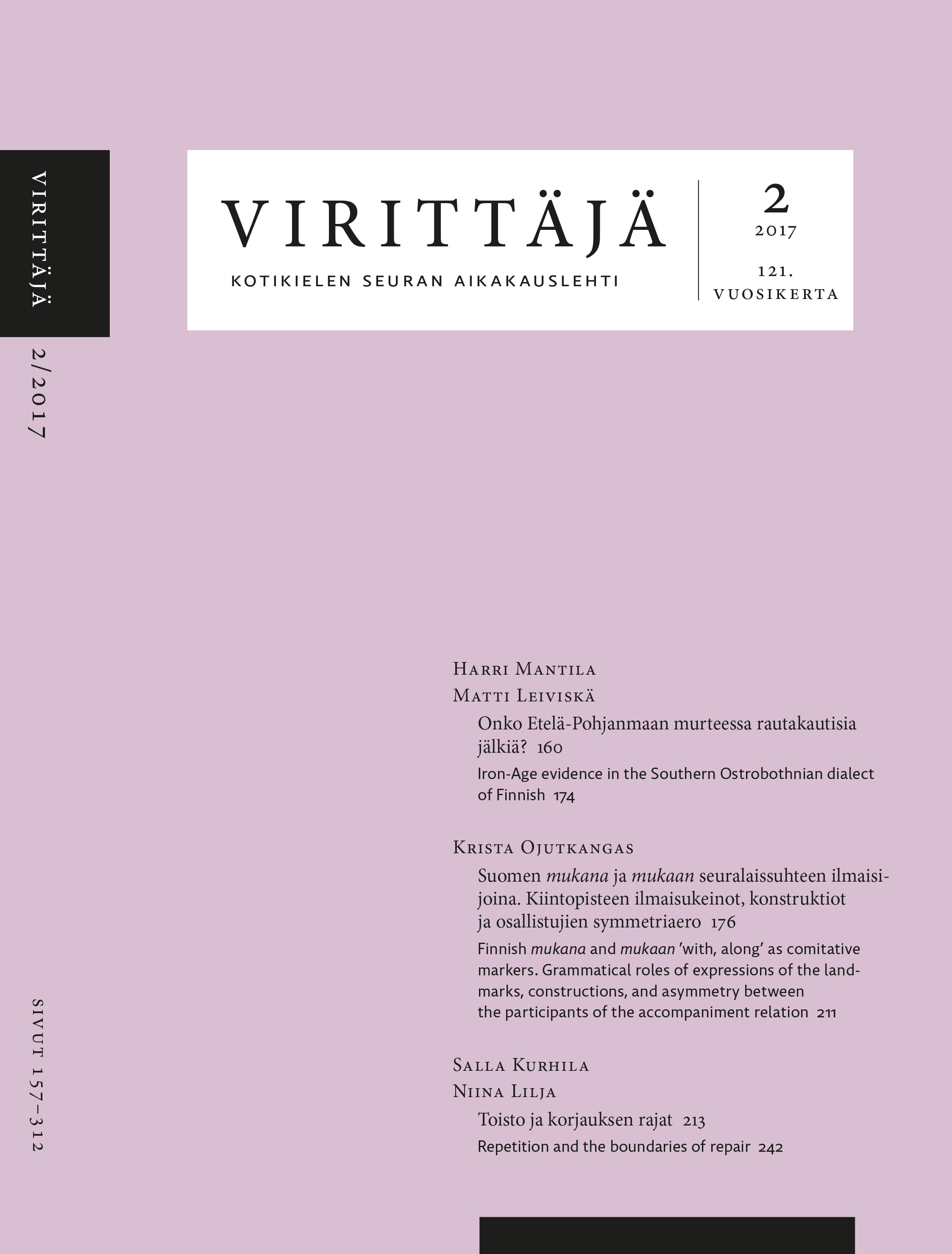Onko Etelä-Pohjanmaan murteessa rautakautisia jälkiä?
Abstrakti
On vanhastaan tunnettua, että Etelä-Pohjanmaan murteessa esiintyy arkaismeja, jotka ovat vieraita muille suomen länsimurteille. Tässä artikkelissa analysoidaan yhdeksän arkaistisen eteläpohjalaisen piirteen levikkiä ja historiaa ja suhteutetaan niitä tämänhetkiseen arkeologiseen tietoon Etelä-Pohjanmaan asutuksesta. Tulos on, että useat näistä piirteistä ovat tunnettuja savolaismurteissa, karjalan kielessä ja jopa vepsässä. Eteläpohjalais-savolais-karjalaisia yhteisiä piirteitä ovat esimerkiksi otti(j)a-tyyppiset monikon 2. persoonan alkuperäiset imperfektimuodot. Vepsään saakka ulottuvat Ut-nominien si-aineksiset monikkovartalot, esimerkiksi neittysillen, vepsän regusid (’kelkkoja’). Murteen snA ~ hnA -päätteinen inessiivi on tunnettu vain etelävirossa, ja saita-tyyppiset monikon 2. persoonan verbinmuodot ovat itämerensuomalaisella kielialueella tuntemattomia. Nämä kaksi piirrettä ovat siis ilmeisesti vieläkin vanhempia ja näyttäisivät edellyttävän myöhäiskantasuomalaista tai jopa vanhempaa kantakielivaihetta.
Tutkittujen piirteiden levikki- ja historiatietoja verrataan artikkelissa arkeologien nykynäkemyksiin, joiden mukaan pohjoiskantasuomalainen tai muinaishämäläinen vaikutus ylsi rautakauden lopussa Etelä-Pohjanmaalle, Savoon Mikkelin seudulle sekä muinaiskarjalaisille alueille – jopa vepsään saakka. Tämän ajattelun mukaan Etelä-Pohjanmaan murteen arkaistiset piirteet periytyisivät tästä samasta kantakielivaiheesta ja kertoisivat murteen rautakautisesta kerrostumasta.
Etelä-Pohjanmaalla on vanhastaan tiedetty olleen vahva asutus jo rautakauden alussa (500 eKr.). Sen on kuitenkin ajateltu tuhoutuneen viikinkiaikaan eli noin vuoteen 800 jKr. mennessä, ja alueen murteen on oletettu syntyneen 1000-luvun ensimmäisinä vuosisatoina Hämeestä ja Varsinais-Suomesta tulleen uuden asutuksen myötä. Nykyisin ajatellaan, että Etelä-Pohjanmaan asutus säilyi rautakauden läpi, joskin köyhtyneenä. Artikkelin päähuomio on, että arkeologian nykytulokset mahdollistavat sen tulkinnan, että mainitut arkaismit ovat jo rautakaudella Etelä-Pohjanmaalle levinneen kielimuodon reliktejä. Samoin voidaan ajatella, että kielitiede tukee arkeologien näkemystä Etelä-Pohjanmaan asutuksen jatkuvuudesta läpi rautakauden.
Iron-Age evidence in the Southern Ostrobothnian dialect of Finnish
It has long been recognised within the field of Fennistic research that the Southern Ostrobothnian dialect contains archaic features that are unknown in other western Finnish dialects. In this article, the writers analyse the spread and history of nine such features in the light of recent archaeological research. One significant finding is that many of these features are already familiar from the dialects of Savo, the Karelian language and even Vepsian. Examples of common features found in the dialects of Souther-n Ostrobothnia and Savo, as well as in Karelian, are original 2nd person plural imperfect forms such as otti(j)a (’you took’). One common feature of Vepsian is a plural stem with -si for Ut nouns such as neittysillen (’to the maids’) and the Vepsian regusid (plural partitive for ’sleigh’). The inessive ending snA ~ hnA is known only in South Estonian, and 2nd person plural verb forms such as saita (’you got’) are not known at all in Finnic. It appears, therefore, that these two features are even older, and seem to descend from late Proto-Finnic or earlier still.
This article compares the spread and history of the features analysed to the view of contemporary archaeological scholarship, which contends that by the end of the Iron Age the influence of Northern Proto-Finnic or Ancient Häme (Tavastian) had reached Southern Ostrobothnia, the region of Mikkeli in Savo, ancient Karelian areas and even all the way to Vepsian-speaking regions. Accordingly, the archaic features of the Souther-n Ostrobothnian dialect would have descended from the same phase of the proto-language and are thus an indication of remnant Iron-Age layers in the dialect.
It has long been known that settlements were common throughout Southern Ostro-bothnia from the beginning of the Iron Age (500 BC). However, it has previously been thought that these settlements were destroyed during the Viking period in approximately the 8th century, and it was assumed that the local dialect was created in the first centuries after the year 1000 as a result of new settlements arriving from Häme (Tavastia) and Southwest Finland. However, it is now widely accepted that, though they were greatly impoverished, settlements in Southern Ostrobothnia existed throughout the Iron Age. The primary observation of this article is that present archaeological eviden-ce allows scholars to view the aforementioned archaic features as relics of a language form which spread to Southern Ostrobothnia during the Iron Age. Similarly, the writers contend that Fennistics can now support the archaeological view regarding the continuity of Southern Ostrobothnian settlements throughout the Iron Age.






